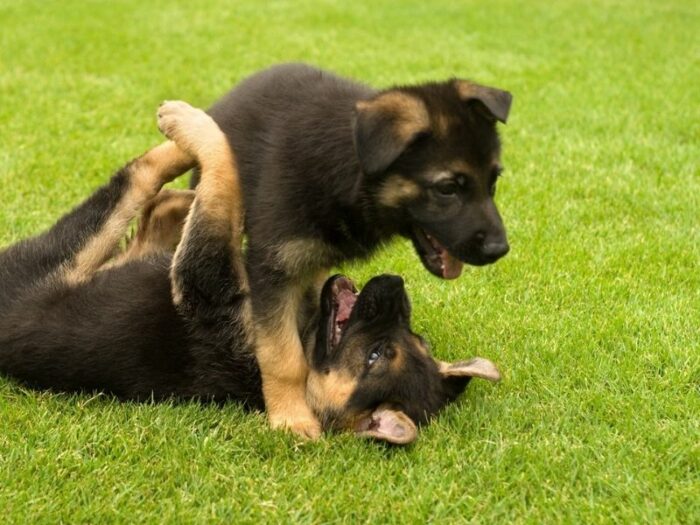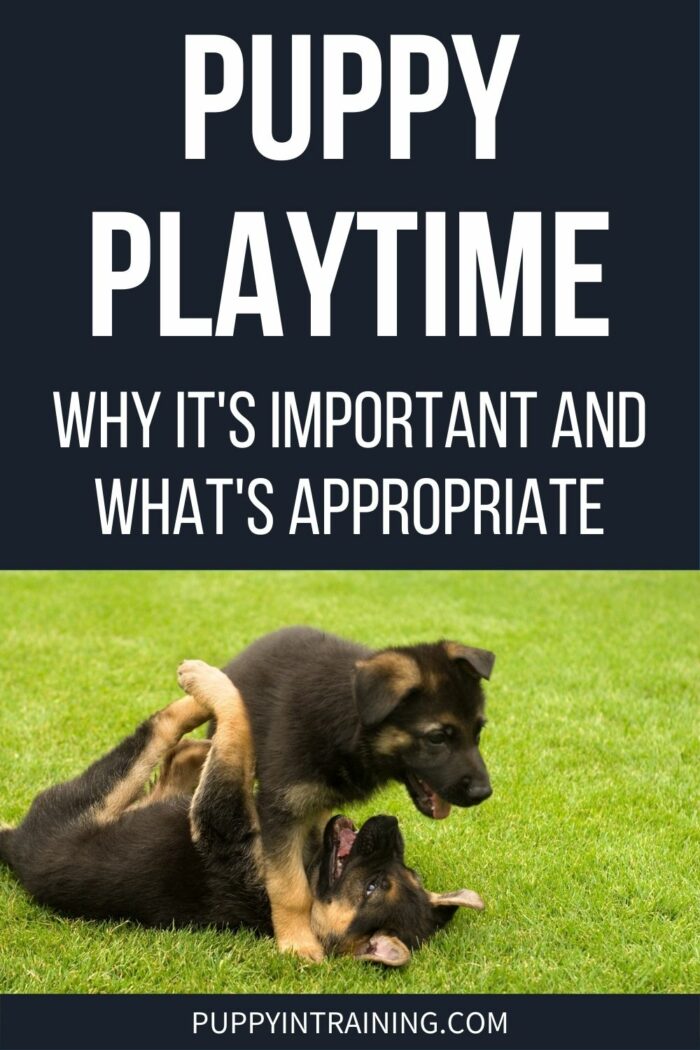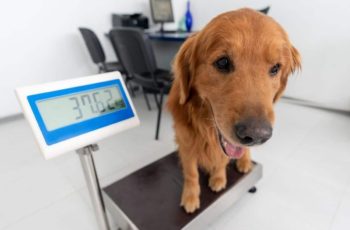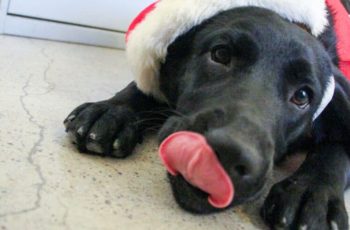This post may contain affiliate links. We may earn money or products from the companies mentioned in this post.
Your new puppy wants to play. And play. It’s so cute when he dips down, yips, and runs around the room. But when is puppy playtime appropriate and when are puppies getting too rough and crazy?
My Aussie mix puppy Millie had boundless energy. She would zoom around the family room, enticing her canine siblings to chase her.
She would play “bitey face” with Ralphie, the Lhasa apso.
And she would bring toys, dropping them at my feet, enticing me to play.

All of this was normal puppy behavior.
In this article, I’ll discuss why puppy play is very important. And what type of play is appropriate and what’s inappropriate.
I’ll also discuss the three types of play: with us, with other puppies, and a puppy playing by himself.
Puppy Playtime: Why Is it So Important?
Of course, appropriate puppy play is FUN. But it’s also very important for a puppy to properly develop.
As soon as puppies become ambulatory, around three weeks old, they usually start to play.
Play helps teach puppies what behavior is acceptable and what’s not.
It also helps a puppy’s cognitive skills develop. The mental stimulation involved in play helps a puppy learn how to solve problems.
It also helps a puppy’s memory. So, play actually increases his “brainpower.”
Even though puppies can be a bit clumsy, play helps them to discover how their bodies work. It teaches motor skills.
Playing With Other Puppies
There are many other reasons to make sure a puppy plays with other puppies, with us, and even by himself.
You know the saying that “a tired dog’s a good dog.”
It’s true that a puppy that has a sufficient amount of physical and mental stimulation will generally be better-behaved than one that hasn’t.
Play helps eliminate a pup’s stress too.
Playing with other canines teaches a puppy to have proper social skills.
At the shelter where I teach classes, there is a puppy socialization class. Puppies play with each other and the trainer and assistants supervise the class.
Proper ways to play are ensured because all interactions are monitored. If the play gets too rough, it’s interrupted.
Play teaches social skills and how to behave with other dogs. This skill should have a lifelong effect in how your puppy interacts with dogs later in life.
Play also teaches a puppy to be resilient when faced with new situations.
For example, during play energetic puppies may accidentally knock a toy or other object off a table or chair. A puppy should learn to recover and become resilient to such unplanned noises and motions.
Puppies also learn bite inhibition when playing with other puppies. This too should help your puppy interact with other canines–and with you–throughout his life.
So, playing with other puppies teaches many behaviors that will be useful in his interactions with other canines.
Playing With Us
Play provides many teachable moments for our puppies. It teaches puppies that we are fun to be around.
And it also teaches some impulse control because the puppy needs to learn certain behaviors for the play to continue.
You can have your puppy sit before throwing the toy, for example. Or playing tug and release can teach a puppy to play appropriately with us.
For fetching or releasing a tug toy, you can teach your puppy to give up or drop a toy. And it can teach him how to retrieve a toy on cue.
It can also teach a puppy not to be rough with us because the game ends when he starts to become over-stimulated or mouthy.
Playing interactive games with us, such as the “find me” game, can also help a puppy have a reliable recall.
You can also hide toys or treats for the puppy to find on cue.
Or you can use a flirt pole, enticing your puppy to chase the toy at the end of the cord. The puppy has fun and it teaches him how to coordinate his body movements.
Even training a puppy to perform obedience commands can be seen as play to a puppy when done using positive reinforcement.
Puppy Playtime By Himself
A puppy should also learn how to be alone and amuse himself. Otherwise, he could become too anxious when left alone, potentially even leading to separation distress.
Self-directed play can serve as a substitute for a play partner. And it can also be fun in and of itself.
This behavior can be demonstrated when a puppy chases his tail or pounces on imaginary objects.
But note that if these behaviors occur too often, they may indicate an obsessive-compulsive disorder requiring a veterinary behaviorist to address the problem.
When my sheltie Murphy was a puppy, he would sometimes chase his shadow or reflection. It was typical herding behavior of his breed.
But had it occurred constantly or more than a few times a day, I would have been concerned.
Mounting or pretend play killing and shaking a toy can also be an acceptable demonstration of a puppy entertaining himself.
Puppies can also play by themselves with their toys. Activity toys, such as puzzle toys, snuffle mats, ball pits with kibble scattered, and treat-dispensing balls, can also expand a puppy’s mind and teach him that being alone can be fun too!
Puppy Playtime: How Much Is Enough–or Too Much?
Unfortunately, there is no set formula regarding how much play is necessary for any puppy.
It’s always important to check with your vet regarding what’s appropriate for your puppy.
And you can also talk with your breeder, rescue, or breed-specific groups regarding the appropriate amount of exercise for your young puppy.
But there are certain guidelines you can follow.
You don’t want your puppy to have the “weekend warrior” syndrome where he only exercises a few days a week.
Just as we can get hurt, a puppy can too if he doesn’t get regular, consistent play.
I’m sure that you’re aware of the syndrome.
If we sit at a desk all week, then suddenly go for long hikes on the weekend, we’re likely to have sore muscles.
And we can even pull something and have a long recovery time.
Not giving regular, consistent exercise to your puppy can lead to sore muscles and even damage to his growing body.
It’s also important to vary the type of activities.
Go for walks, play fetch and tug with toys, and hide toys or treats for the puppy to find.
Get your pup used to different surfaces such as grass or cement.
But be sure not to have a lot of play on hard surfaces or you may damage your puppy’s structure.
Only increase the length of your walks or play sessions slowly over days and weeks.
Take frequent breaks and have rest periods as needed when playing or walking.
Three or four short exercise sessions–walks and play–should help to maintain your pup’s physical and mental health.
Of course, don’t forget to add in some activity toys and training sessions for optimal mental stimulation.
End each session before your puppy becomes too tired. You’ll get to know your pup and his limits.
Generally, as a puppy grows, his tolerance for play and exercise increases.
But remember if you see any lameness to promptly end the session and seek veterinary help.
One other consideration regarding how much exercise your puppy may need or tolerate is his breed or mix. A herding, working, sporting, or terrier breed will probably have greater exercise needs than a toy breed will.
So your border collie, Aussie, Doberman, retriever, or westie will have greater exercise tolerance and need than your Shih Tzu or Maltese will.
You also need to take into consideration that larger breeds like labs and Great Danes will be more subject to structural damage if over-exercised.
Puppy Playtime: What’s Appropriate
Although play is a natural canine behavior, not all puppy play should be permitted.
Of course, if you know of a friendly, compatible puppy, play can be great for your puppy’s socialization, exercise, and development.
But there should be no bullying. And the puppies should be equally matched and have similar play styles.
Size does matter. A puppy who is too large may inadvertently injure a smaller pup.
So, even though my Shih Tzu puppy China wanted to play with Great Dane Otto in her puppy kindergarten, she was put in a playgroup that was more appropriate.
If you’re not sure whether an interaction is play not bullying, separate the puppies briefly and then see if they both want to re-engage.
So, what should you look for when deciding whether play is appropriate?
Puppy play should look like the participants are having FUN. Some things to look for are:
- A relaxed jaw with visible teeth (a happy-looking mouth)
- Bouncy, fun play
- Relaxed body language (happy wagging tail, loose body language, wiggly body language)
- Play bow (where pup’s rear remains in the air, and his front end dips down)
- Raised paw inviting play
- Rolling on back inviting play
- Vocalizing with a play growl (not deep-throated) or happy yips
- Chasing where both participants engage
- Reversal of roles (where no one dog is pinned or chased)
- Wrestling where no puppy is pinned and both engage in rolling around
- Self-handicapping play where a puppy self-regulates with inhibited play bites
- Play where both puppies want to engage with the other
- A shake-off (as if the pup is shaking off water), defuses stress or means that play is winding down
- Soft mouthing or play biting (usually of the face or legs)
- Leaping forward with a nose poke, then retreating as an invitation to play
- Face pawing or licking the other puppy
So watch the interaction and body language of the puppies playing.
They should be having fun and not appear stressed. The roles should be equal where no puppy is constantly pinned or chased.
Instead, each puppy should engage the other, often reversing pinning/wrestling, mouthing, or chasing roles.
And shyer puppies should be protected from play that they can’t handle.
This pretend aggression where puppies growl, wrestle, play-bite, play bow, and wiggle back-and-forth serves a purpose.
It helps build a puppy’s confidence and invites the other participant to play.
When my Aussie mix puppy Millie played in her puppy playgroup, the participants switched off chasing each other and mouthing and rolling around together. So the puppies all had fun.
In determining what puppies should play together and what’s appropriate play behavior, it’s important to consider each dog’s breed or mix.
Herding dogs and some terriers may naturally engage in chase behavior.
And working and hunting breeds will generally engage in rougher play than some other breeds.
Puppy Playtime: What’s NOT Appropriate
There are certain behaviors that shouldn’t be permitted.
If the play–even if equal–becomes too rough, the puppies should be separated for a cool-down period.
The puppies playing should look like they’re having a good time. They shouldn’t appear to be stressed or defensive.
Some behaviors that shouldn’t be allowed include the following:
- Neck and face biting that’s not gentle and pinning without role reversal
- Big dogs playing too rough with small dogs
- Play that is too rough or intense where participants become defensive and unable to settle down
- Escalating arousal levels indicated by play that becomes faster or louder that can lead to a fight
- Pinning one dog without role reversal
- Body slamming
- A puppy standing with head over neck and shoulders of play partner
- Deep-throated, low-pitch growling or baring teeth
- Barking in the other puppy’s face
- Relentless chasing where the chased puppy doesn’t want to participate
- Cornering or ganging up on a puppy
- Hair pulling
- Mounting (which indicates over-arousal, not dominance)
The main goal is to ensure that all puppies engaged in play are having a good time.
The above behaviors are red flags that must be taken seriously.
Watch to ensure that a puppy who doesn’t want to engage and tries to retreat is removed from the play.
Tense, fearful body language of a participant (tense brow, tucked tail, drooling) should be respected and the play should end.
The same is true if a puppy sharply yelps.
If you stop the play before things escalate and before any bullying occurs, your session will be successful. No puppy should feel overwhelmed or defensive.
FAQs
How do I determine how much exercise my puppy needs?
It’s always good to check with your vet and other pet professionals such as your breeder or rescue to determine what’s appropriate.
As a general guideline, certain types of dogs require more exercise than others. For example, herding, sporting, and terrier breeds generally require more exercise than toy breeds do.
My puppy always pins his playmate, who yelps when pinned. Should I allow this? No! If the play isn’t equal, it just teaches your puppy to be a bully.
And it teaches the other puppy that play isn’t good. It can also teach his playmate to become defensive and aggressive.
How can I play with my puppy?
Of course, you can play games with your puppy, such as hide-and-go-seek or hiding treats or toys for him to find. You can also play tug or fetch with him. And you can teach him that obedience commands are a fun game as well.
Final Thoughts
Puppy play is very important. It can exercise his body and mind. And it can teach him many lessons that will be useful throughout his life, such as what behavior is and is not acceptable.
But not all play should be encouraged. If play is too rough or unequal with other puppies, it shouldn’t be permitted.
It’s crucial to a puppy’s development that he learns to play with us, with other canines, and by himself.
Do you regulate your puppies playtime?
Tell us about your puppy and your experiences in the comment section below.
Save To Pinterest

Top Picks For Our Puppies
- BEST PUPPY TOY
We Like: Snuggle Puppy w/ Heart Beat & Heat Pack – Perfect for new puppies. We get all of our Service Dog pups a Snuggle Puppy. - BEST DOG CHEW
We Like: Best Bully Sticks – All of our puppies love to bite, nip, and chew. We love using Bully Sticks to help divert these unwanted behaviors. - BEST DOG TREATS
We Like: Wellness Soft Puppy Bites – One of our favorite treats for training our service dog puppies. - BEST FRESH DOG FOOD
We Like: The Farmer’s Dog – A couple months ago we started feeding Raven fresh dog food and she loves it! Get 50% off your first order of The Farmer’s Dog.
Check out more of our favorites on our New Puppy Checklist.


